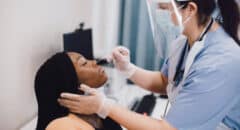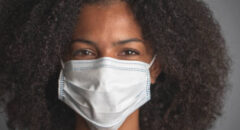
The Omicron variant is spreading rapidly in the United States and could trigger a huge wave of COVID infections as early as January, according to federal health officials.
In just one week there was a sevenfold spike in the highly contagious variant's presence across the nation, according to the U.S. Centers for Disease Control and Prevention. That could strain an already overworked health system in many areas as the Delta variant continues to surge.
That was the worst-case scenario presented in a new analysis discussed by agency officials during a media briefing.
RELATED: New Symptoms of the Omicron Variant
The spike in Omicron cases
The early signs are worrying: From Dec. 4 to Dec. 11, the Omicron variant likely jumped from a mere 0.4 percent of new infections in the United States to 2.9 percent, according to the new CDC data. In New York and New Jersey, Omicron already accounts for 13 percent of new cases.
In the Houston Methodist hospital system, Omicron accounted for 13 percent of new cases in a four-day period leading up to Dec. 8, James Musser, chair of pathology and genomic medicine there, told the Washington Post. The Omicron variant was first detected in Houston on Nov. 29.
“We’ve had 21 months of this now, and we’re sort of — I hate to say it, because it’s tragic — but we’re sort of skilled in the art of how to handle this,” Musser adds.
In the CDC media briefing, the agency told public health officials that "we got to get people ready for this," Marcus Plescia, chief medical officer for the Association of State and Territorial Health Officials, told the Post.
RELATED: FDA Approves New Antibody Drug to Fight Omicron Variant
He said the Omicron and Delta variants, combined with seasonal flu, could turn out to be "triple whammy" and that he's "a lot more alarmed" after the CDC briefing.
The second scenario shows a smaller Omicron surge in the spring, but it’s unclear which scenario is more likely, the Post reports.
The scenarios were given to senior White House officials as they decide whether, when and how to take new steps to combat the virus.
Omicron vs. other variants
There is some fresh data to consider: A study out of South Africa released last week showed that while the variant is more contagious than any scientists have seen so far, Omicron cases tend to be mild.
“They’re considering the information at the highest levels right now, and thinking through how to get the public to understand what the scenarios mean,” a federal health official familiar with the briefing told the Post. “It looks daunting.”
The official says the "implications of a big wave in January that could swamp hospitals … we need to take that potential seriously.”
The CDC's latest analysis of Omicron's spread matches that of several U.S. academic groups and data from the U.K., Denmark and Norway, the Post reports.
Early data show that fully vaccinated people who receive a booster shot remain largely protected against severe illness and death from Omicron, but there are concerns about how few Americans have gotten boosters, officials say.
Of the 200 million fully vaccinated people in the United States, more than 50 million have now received boosters, according to the CDC.
RELATED: Omicron vs. Delta: Three Key Differences Between the Two Variants
What to do if you test positive for COVID
"All of the same things stand, whether it’s Delta, Omicron, or any other Greek letter or non-Greek letter of SARS-CoV-2,” says Stephen Kissler, an epidemiologist at Harvard. “Once you know you’re infected, hang tight, limit your encounters with other people, and just take care of yourself.” You should also notify anyone that has been in close contact with you so that they can get tested as well.
Do you need a second test?
If you tested positive after taking a rapid home test, you should consider taking a second home test using a different brand or go to a testing center to confirm the result. Although rare with home tests, false positives can happen. If your test came from a laboratory, a second test isn't needed.
How long should you isolate?
According to the CDC’s guidelines, you should isolate if you’ve either tested positive in the past 10 days or are experiencing symptoms, and end your isolation after 10 days only if you’ve gone 24 hours with no fever (without the use of Tylenol or other anti-fever drugs) and your other symptoms are improving (not counting the loss of taste and smell), which could take a couple of weeks to return.
RELATED: A Guide to Help You Keep Up With the Omicron Subvariants
What should you do if you live with other people?
If you live with roommates or family, try to separate yourself from other people (and animals) as much as possible to avoid infecting them. “You should take yourself out of society,” Dr. Peter Chin-Hong, an infectious disease expert at the University of California, San Francisco, says. “Wall yourself up in a cocoon”. This means staying in your room and designating specific parts of the house as only for you. You can have someone deliver essentials, such as meals, to your door.
If you are unable to designate certain areas of the house to the infected person, everyone should wear masks when entering these rooms.
“The most important thing is keeping people from breathing air that is filled with germs,” Tara Kirk Sell, a senior scholar at the Johns Hopkins Center for Health Security says. Placing a HEPA air cleaner in or outside your bedroom can help as well. It also doesn't hurt to wipe down shared spaces to prevent the spread of germs.
After using a shared bathroom, disinfect the toilet seat and handle, as well as the faucet handles, soap dispenser, counter and light switch. You should also close the lid before you flush, turn on the exhaust fan and open windows to improve ventilation in shared areas.
If the infected person is a child or older person who needs assistance, both the caregiver and the infected person should wear a mask when entering the room.
When to call your doctor
If you develop a fever, cough or shortness of breath, call your healthcare provider’s office. Your doctor will determine whether you should be seen by a physician.
RELATED: Does Omicron Require a New Vaccine?
If your symptoms become severe — especially if you are having trouble breathing, have pain or pressure in the chest, bluish lips or feel confused — call 911 or go to your nearest emergency department.
It’s vital to call ahead to let healthcare personnel know you’re coming and what your symptoms are, according to the U.S. Centers for Disease Control and Prevention (CDC).
Treatment
You can use a pulse oximeter to keep track of your blood oxygen levels. Most healthy people will get an oxygen reading of around 95 to 99 percent. If the reading drops quickly or the level dips to 93 percent or lower, seek medical advice. For people with darker skin the device may be less accurate, so pay attention to the trend. If your reading drops by four points or your condition worsens, contact your doctor.
If you fall in the high-risk group, consider asking your doctor if you are eligible for monoclonal antibodies, a treatment that can help your body fight COVID-19 and lower your risk for severe illness. The FDA-approved treatment was recently expanded to include monoclonal antibodies for children as well. However, this treatment has to be administered in a clinic or hospital, as an IV infusion or as four shots — but it can be highly effective. One study found an 85 percent reduction in the risk of hospitalization or death. Research is underway to see if this form of treatment will be effective in fighting against the Omicron variant.
You should also:
- Take medications, like acetaminophen or ibuprofen, to reduce fever.
- Drink water or receive intravenous fluids to stay hydrated.
- Get plenty of rest to help the body fight the virus.









